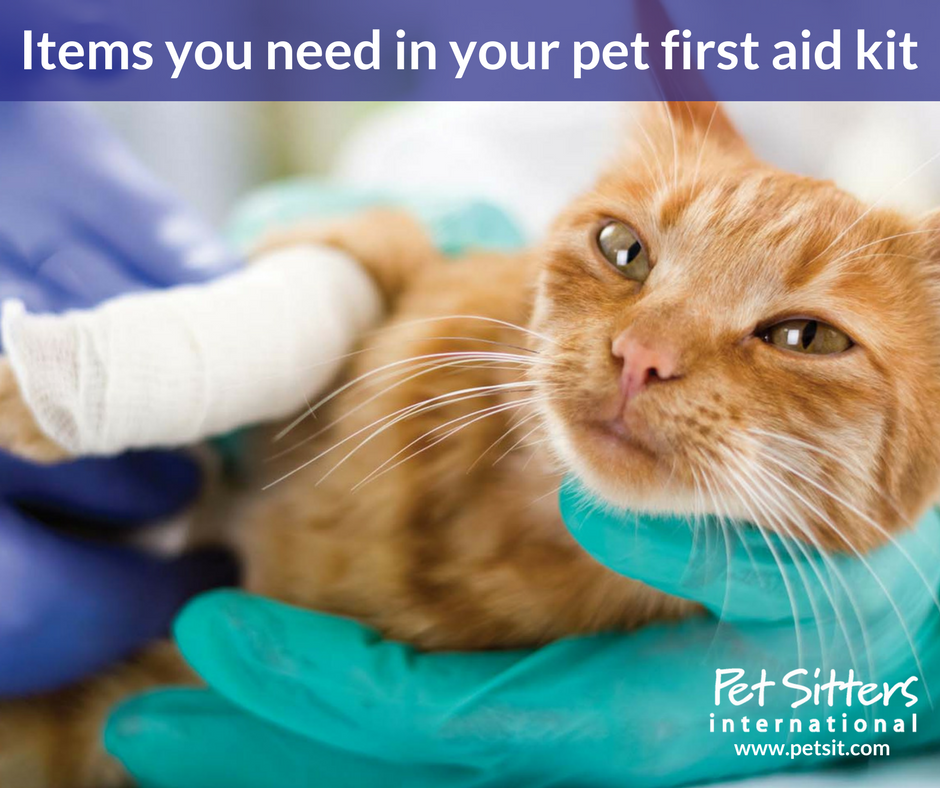Source: https://www.petsit.com/items-you-need-in-your-pet-first-aid-kit
Items you need in your pet first aid kit

Just like people, most pet accidents happen in or nearby the home. Examples of the most common pet accidents include: toxic ingestion, dog bites, high rise syndrome, ripped toenails, foreign body ingestions with gastrointestinal problems, eye emergencies, broken bones, trouble giving birth and being hit by a car. One way to be prepared is to have a pet first aid kit on hand.
An article in a previous issue of PSI’s Pet Sitter’s World magazine offered these suggestions for your Pet First Aid Kit, provided by Pet Poison Helpline®.
Dog and Cat Pet First Aid Kit contents:
- Hydrogen peroxide 3% (within the expiration date)
- An oral dosing syringe or turkey baster (for administering hydrogen peroxide)
- Teaspoon/tablespoon set (to calculate the appropriate amount of hydrogen peroxide to give)
- Liquid hand dish washing detergent (i.e., Dawn, Palmolive)
- Rubber gloves Triple antibiotic ointment with NO other combination ingredients—NOT for use in CATS!)
- Vitamin E oil
- Diphenhydramine tablets 25 mg (with NO other combination ingredients)
- Ophthalmic saline solution or artificial tears
- Can of tuna packed in water or tasty canned pet food
- Sweet electrolyte-containing beverage
- Corn syrup
- Vegetable oil
Based on recommendations from the American Veterinary Medical Association (AVMA), you should also consider including these additional items:
- Gauze
- Nonstick bandages (or towels/cloth strips)
- Adhesive tape for bandages (Do not use human adhesive bandages.)
- Milk of Magnesia
- Digital thermometer
Having an extra leash in your kit is also a good idea, and make sure that you always have the phone numbers for your veterinarian and the local emergency veterinary clinic handy. Pet sitters, its important you also have this information from your clients.
Remember, before you attempt anything with your new pet first aid kit, it is always important to speak with a poison control specialist before you try any therapies at home. You will never want to administer the hydrogen peroxide to a pet without checking with a veterinary professional first. In some situations, it is not appropriate to induce vomiting at home. You should also never administer over-the-counter human medications to pets without first speaking to a toxicologist or veterinary professional. One helpful resource is the Pet Poison Helpline: 1 (800) 213-6680 or www.petpoisonhelpline.com.
According to the American Animal Hospital Association (AAHA), 25 percent more pets would survive if just one pet first aid technique were applied prior to getting emergency veterinary care.
After you’ve administered first aid, it is still extremely important to seek veterinary care as soon as possible. Many emergencies cannot be managed—even in the initial period—with simple pet first aid procedures. Call your veterinarian (or, if pet sitting, the client’s veterinarian), an emergency veterinary center or poison control immediately—and remember, above all, to STAY CALM.
Because toxic ingestion (pet poisons) is such a common pet accident, it’s also important to be familiar with the most common pet toxins. Members of Pet Sitters International have access to resources to keep the pets in their care healthy, happy and safe year-round.
